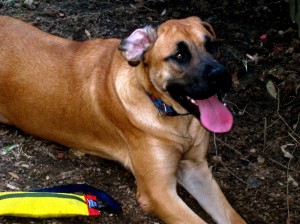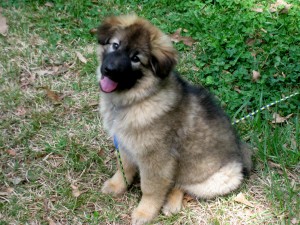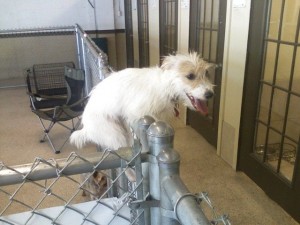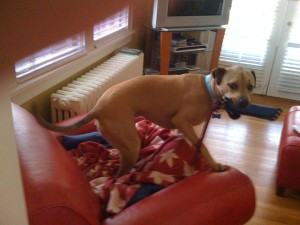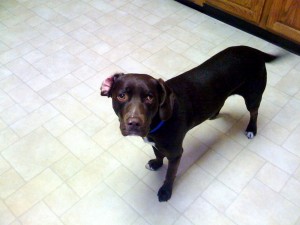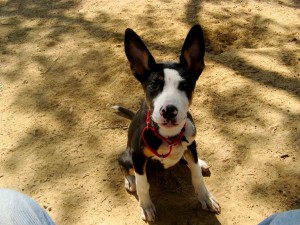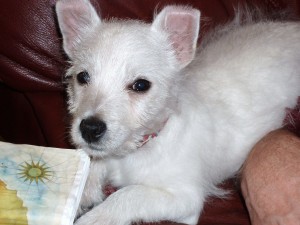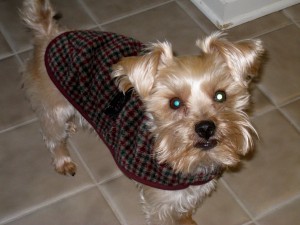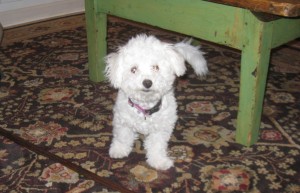Why wouldn’t a dog bolt through an open door? Because you teach him not to, that’s why! 🙂
Does your dog race through open doors and gates? Most people either pick up their dogs or hold the dog’s collar to prevent door bolting behaviors. Both of these actions “pay” the dog for trying to run through the door.
The ultimate pay is the chase and adventure of escape. Every time your dog escapes, and you chase him, you are increasing naughty behaviors!
Here is a simple exercise to teach your dog to wait patiently when people pass through doors and gates. The concept can be applied to other doors and gates after your dog perfects the skill at home.
Off leash obedience is an advanced skill, even when the dog is in a fenced area. Before you can expect your dog to obey when he or she is 50 feet away, first you should practice when the dog is on a short leash, then a long line.
Don’t let your dog be the last to know if he or she is invited to pass though the doorway and explore the neighborhood.
Teach Door!
Here’s how to teach your dog to wait while you pass through open doors or gates.
Prerequisite:
Time to perfection varies with the experience of the handler, the handler’s goals for distractions, and the experience of the dog. A dog who has already perfected a few commands, and has not practiced escape behaviors can learn the general concept in one, 15 minute session.
Description: Teaches the dog to remain in one location when people enter and exit doorways.
Function: Default behavior when people open doors or gates
Before your dog learns this command, attach a leash and hold it so that your dog cannot practice bolting through doorways!
Like many training exercises, you’ll teach your dog in cycles. Each cycle introduces a bit more information and teaches your dog about distractions.
If, during any of these cycles of learning, your dog moves towards the door, communicate with actions, not words. Here’s what you should do if your dog moves towards the door.
A) Do not praise and treat.
B) At the first sign of failure, block the dog’s path with your body and body block or herd the dog back to the desired location. This teaches the dog that moving towards the door (when you say “door game”) is impossible.
C) Close the door (if applicable) and return your hand to your side. This teaches the dog that moving towards the door “makes” the door close.
D) Repeat the cycle, with a lesser distraction.
Step 4 of each cycle is when you increase the distraction.
Get creative with your distractions. Think of daily occurrences at the door, and magnify. Make your practice sessions “tougher” than real life.
For example, you may want to teach your dog to wait when you walk through the door backwards, dancing and singing a song!
Ideas for distractions:
marching in place;
reaching for the door;
touching the handle;
jiggling the handle;
turning the handle;
opening the door 3 inches and closing it;
opening the door 10 inches and closing it;
opening the door 2 feet and closing it;
taking 1 step towards the door;
taking 1 step away from the door;
walking into the door way;
walking through the door and back inside;
walking while carrying an interesting item;
items, people or animals on the “dog side” of the door;
items, people, or animals other side of the door;
people passing through the door
people passing through the door with items in their hand
Here are examples of how the initial 5 cycles might progress if the dog succeeds on each cycle. If the dog fails, back up a cycle or two and start again.
If you are working at an exit door without a fenced yard, attach a leash and hold the end of the leash during each cycle, or tether the end of the leash to something inside the house.
Notice the only difference between cycles is step 4.
Cycle 1
1) Say “Door” in an upbeat tone.
2) Push your hand outward towards your dog, palm facing the dog like a stop signal.
3) Wait 1 second and withdraw your “stop signal”.
4) Stand still for 3 seconds.
5) Deliver your reward marker.
6) Toss your dog a treat so that he moves from his current location to get the treat.
Cycle 2
1) Say “Door” in an upbeat tone.
2) Push your hand outward towards your dog, palm facing the dog like a stop signal.
3) Wait 1 second and withdraw your “stop signal”.
4) March in place for 3 seconds.
5) Deliver your reward marker.
6) Toss your dog a treat so that he moves from his current location to get the treat.
Cycle 3
1) Say “Door” in an upbeat tone.
2) Push your hand outward towards your dog, palm facing the dog like a stop signal.
3) Wait 1 second and withdraw your “stop signal”.
4) March in place and reach towards the door handle.
5) Deliver your reward marker.
6) Toss your dog a treat so that he moves from his current location to get the treat.
Cycle 4
1) Say “Door” in an upbeat tone.
2) Push your hand outward towards your dog, palm facing the dog like a stop signal.
3) Wait 1 second and withdraw your “stop signal”.
4) March in place and reach towards the door handle, jiggle the handle.
5) Deliver your reward marker.
6) Toss your dog a treat so that he moves from his current location to get the treat.
Cycle 5
1) Say “Door” in an upbeat tone.
2) Push your hand outward towards your dog, palm facing the dog like a stop signal.
3) Wait 1 second and withdraw your “stop signal”.
4) March in place and reach towards the door handle, jiggle the handle, open door 3 inches and then close the door.
5) Deliver your reward marker.
6) Toss your dog a treat so that he moves from his current location to get the treat.
Introduce more distractions during additional cycles. After each cycle give your dog a short tension rest. Deliver food treats, or verbal praise, quick game of tug, toss a ball, etc.
Once your dog is patiently waiting when the door is wide open, and you are walking in and out the door; enlist friends and family members to knock on your door. Once he perfect the ‘Door” command, you can add another cue. My favorite is a hand signal, a sort of back away motion with my hand, as my back is turned towards the dog.
Happy Training!
AT
Alan J Turner, Companion Animal Behavior Counselor & Trainer – Canine Specialization
Private and Group Dog Training in Memphis, TN
Owner: How’s Bentley

